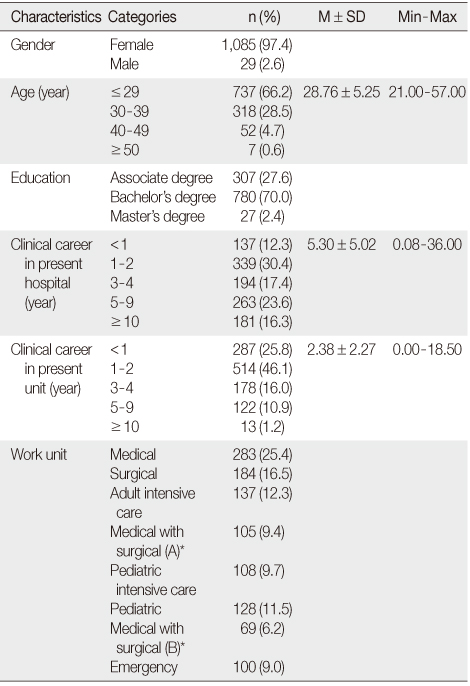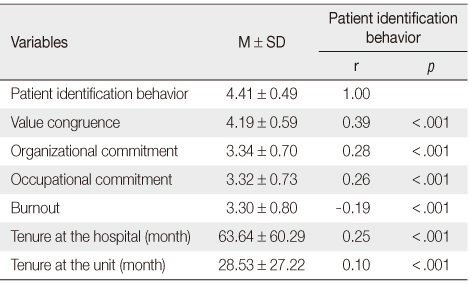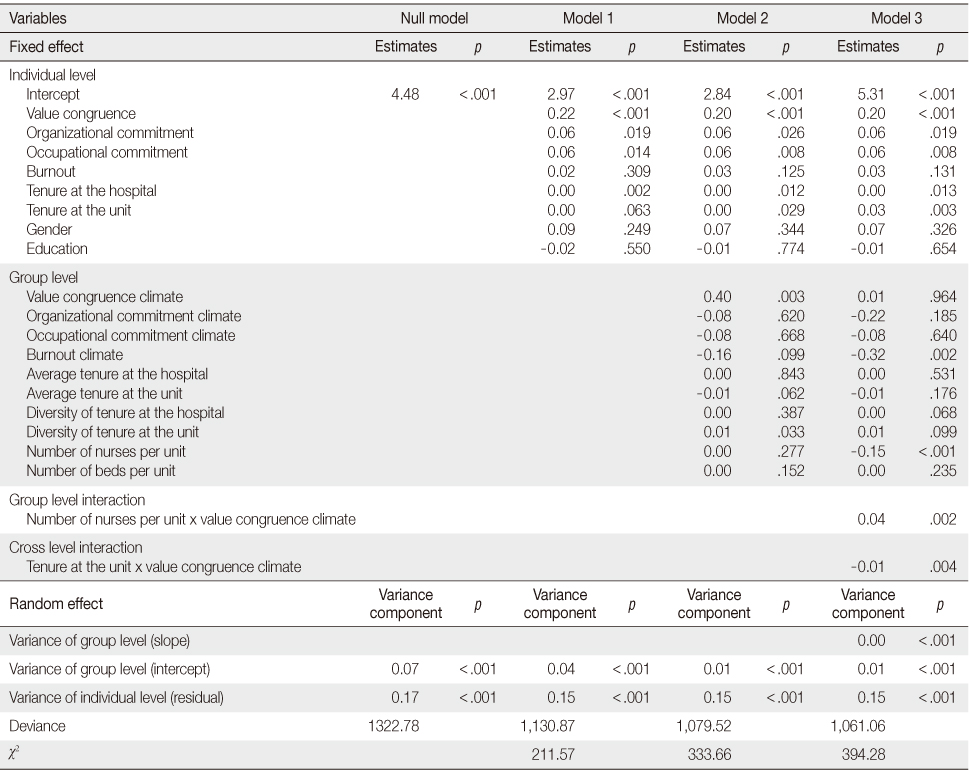Articles
- Page Path
- HOME > J Korean Acad Nurs > Volume 44(2); 2014 > Article
-
Original Article
- Factors related to Nurses' Patient Identification Behavior and the Moderating Effect of Person-organization Value Congruence Climate within Nursing Units
- Young Mee Kim, Seung-Wan Kang, Se Young Kim
-
Journal of Korean Academy of Nursing 2014;44(2):198-208.
DOI: https://doi.org/10.4040/jkan.2014.44.2.198
Published online: April 30, 2014
1Department of Nursing, Seoul National University Hospital, Seoul, Korea.
2College of Business and Economics, Korea University, Sejong, Korea.
3Department of Nursing, Changwon National University, Changwon, Korea.
- Address reprint requests to: Kang, Seung-Wan. Department of Business Administration, College of Business and Economics, Korea University, 2511 Sejong-ro, Sejong 339-700, Korea. Tel: +82-44-860-1524, Fax: +82-44-860-1521, global7@korea.ac.kr
© 2014 Korean Society of Nursing Science
This is an Open Access article distributed under the terms of the Creative Commons Attribution NoDerivs License. (http://creativecommons.org/licenses/by-nd/4.0/) If the original work is properly cited and retained without any modification or reproduction, it can be used and re-distributed in any format and medium.
Abstract
-
Purpose
- This research was an empirical study designed to identify precursors and interaction effects related to nurses' patient identification behavior. A multilevel analysis methodology was used.
-
Methods
- A self-report survey was administered to registered nurses (RNs) of a university hospital in South Korea. Of the questionnaires, 1114 were analyzed.
-
Results
- The individual-level factors that had a significantly positive association with patient identification behavior were person-organization value congruence, organizational commitment, occupational commitment, tenure at the hospital, and tenure at the unit. Significantly negative group-level precursors of patient identification behavior were burnout climate and the number of RNs. Two interaction effects of the person-organization value congruence climate were identified. The first was a group-level moderating effect in which the negative relationship between the number of RNs and patient identification behavior was weaker when the nursing unit's value congruence climate was high. The second was a cross-level moderating effect in which the positive relationship between tenure at the unit and patient identification behavior was weaker when value congruence climate was high.
-
Conclusion
- This study simultaneously tested both individual-level and group-level factors that potentially influence patient identification behavior and identified the moderating role of person-organization value congruence climate. Implications of these results are discussed.
- 1. Renner SW, Howanitz PJ, Bachner P. Wristband identification error reporting in 712 hospitals. A college of American Pathologists' Q-probes study of quality issues in transfusion practice. Arch Pathol Lab Med. 1993;117(6):573–577.PubMed
- 2. Williams DJP. Medication errors. J R Coll Physicians Edinb. 2007;37(4):343–346.ArticlePDF
- 3. Kim EH. A study on factor analysis and experience of medication errors in nurses. Sorabol Univ J. 2002;21:109–126.
- 4. Benjamin DM. Reducing medication errors and increasing patient safety: Case studies in clinical pharmacology. J Clin Pharmacol. 2003;43(7):768–783.ArticlePubMed
- 5. Son HM. Functional phases and patterns of dialogue sequence in nurse-patient conversation about medication. J Korean Acad Nurs. 2007;37(1):52–63.ArticlePDF
- 6. Gray A, Hart M, Dalrymple K, Davies T. Promoting safe transfusion practice: Right blood, right patient, right time. Br J Nurs. 2008;17(13):812814–817.ArticlePubMed
- 7. Sazama K. Reports of 355 transfusion-associated deaths: 1976 through 1985. Transfusion. 1990;30(7):583–590.ArticlePubMed
- 8. Cho MS, Song MR, Jang MR. Evaluation of the bar code medication administration and blood transfusion system in a tertiary hospital. J Korean Acad Nurs Adm. 2012;18(1):23–32. http://dx.doi.org/10.11111/jkana.2012.18.1.23Article
- 9. Kim KS, Kim JA, Kwon SH, Song MS. Development of the nursing process based performance measurement tool for medication management and blood transfusion. J Korean Clin Nurs Res. 2010;16(1):177–196.
- 10. Chatman JA. Improving interactional organizational research: A model of person-organization fit. Acad Manage Rev. 1989;14(3):333–349. http://dx.doi.org/10.5465/AMR.1989.4279063Article
- 11. Song JS, Yoo TY. The effects of person-organization value fit on person attitude and behavior. Korean J Ind Organ Psychol. 2005;18(2):361–384.
- 12. Meyer JP, Allen NJ, Smith CA. Commitment to organizations and occupations: Extension and test of a three-component conceptualization. J Appl Psychol. 1993;78(4):538–551. http://dx.doi.org/10.1037/0021-9010.78.4.538Article
- 13. Kim NH. A study on the influence of job characteristics on job involvement according to personal characteristics [master's thesis]. Seoul, University of Seoul. 2007.
- 14. Taris TW. Is there a relationship between burnout and objective performance? A critical review of 16 studies. Work Stress. 2006;20(4):316–334. http://dx.doi.org/10.1080/02678370601065893Article
- 15. Park EK. Moderating effects of self-efficacy and leadership between antecedents and burn-out and mediating effects of burn-out on nursing performance [dissertation]. Busan, Inje University. 2010.
- 16. Kozlowski SWJ, Klein KJ. A multilevel approach to theory and research in organization: Contextual, temporal, and emergent processes. In: Klein KJ, Kozlowski SWJ, editors. Multilevel theory, research, and methods in organizations: Foundations, extensions, and new directions. San Francisco, CA: Jossey-Bass; 2000. p. 3–90.
- 17. Purdy N, Spence Laschinger HK, Finegan J, Kerr M, Olivera F. Effects of work environments on nurse and patient outcomes. J Nurs Manag. 2010;18(8):901–913. http://dx.doi.org/10.1111/j.1365-2834.2010.01172.xArticlePubMed
- 18. Ko YK. Identification of factors related to hospital nurses' organizational citizenship behavior using a multilevel analysis. J Korean Acad Nurs. 2008;38(2):287–297. http://dx.doi.org/10.4040/jkan.2008.38.2.287Article
- 19. Hoffman BJ, Bynum BH, Piccolo RF, Sutton AW. Person-organization value congruence: How transformational leaders influence work group effectiveness. Acad Manage J. 2011;54(4):779–796. http://dx.doi.org/10.5465/AMJ.2011.64870139Article
- 20. Posner BZ. Person-organization values congruence: No support for individual differences as a moderating influence. Hum Relat. 1992;45(4):351–361. http://dx.doi.org/10.1177/001872679204500403ArticlePDF
- 21. Han SS, Kim NE. Effects of nurses' perception of servant leadership on leader effectiveness, satisfaction and additional effort: Focused on the mediating effects of leader trust and value congruence. J Korean Acad Nurs. 2012;42(1):85–94. http://dx.doi.org/10.4040/jkan.2012.42.1.85ArticlePubMed
- 22. Kang SY. Effects of creative nursing practice on hospital nurses' job satisfaction and organizational commitment. J Korean Acad Nurs Adm. 2012;18(2):234–243. http://dx.doi.org/10.11111/jkana.2012.18.2.234Article
- 23. Kalliath TJ, O'Driscoll MP, Gillespie DF, Bluedorn AC. A test of the maslach burnout inventory in three samples of healthcare professionals. Work Stress. 2000;14(1):35–50. http://dx.doi.org/10.1080/026783700417212Article
- 24. Raudenbush SW, Bryk AS. Hierarchical linear models: Applications and data analysis methods. 2nd ed. Thousand Oaks, CA: Sage Publications Inc; 2002.
- 25. Podsakoff PM, MacKenzie SB, Lee JY, Podsakoff NP. Common method biases in behavioral research: A critical review of the literature and recommended remedies. J Appl Psychol. 2003;88(5):879–903. http://dx.doi.org/10.1037/0021-9010.88.5.879ArticlePubMed
- 26. Hair JF, Black WC, Babin BJ, Anderson RE. Multivariate data analysis: A global perspective. 7th ed. Upper Saddle River, NJ: Pearson Education; 2010.
- 27. Chan D. Functional relations among constructs in the same content domain at different levels of analysis: A typology of composition models. J Appl Psychol. 1998;83(2):234–246. http://dx.doi.org/10.1037/0021-9010.83.2.234Article
- 28. Klein KJ, Bliese PD, Kozolowski SWJ, Dansereau F, Gavin MB, Griffin MA, et al. Multilevel analytical techniques: Commonalities, differences, and continuing questions. In: Klein KJ, Kozlowski SWJ, editors. Multilevel theory, research, and methods in organizations: Foundations, extensions, and new directions. San Francisco, CA: Jossey-Bass; 2000. p. 512–553.
- 29. Bliese PD. Within-group agreement, non-independence, and reliability: Implications for data aggregation and analysis. In: Klein KJ, Kozlowski SWJ, editors. Multilevel theory, research, and methods in organizations: Foundations, extensions, and new directions. San Francisco, CA: Jossey-Bass; 2000.
- 30. Aiken LS, West SG. Multiple regression: Testing and interpreting interactions. Thousand Oaks, CA: Sage Publications, Inc; 1991.
REFERENCES
Figure & Data
REFERENCES
Citations

- Content Analysis of Patient Safety Incident Reports Using Text Mining: A Secondary Data Analysis
On-Jeon Baek, Ho Jin Moon, Hyosun Kim, Sun-Hwa Shin
Korean Journal of Adult Nursing.2024; 36(4): 298. CrossRef - Compare Value Congruence of Nurse-Patient Assignment with Work Performance in Neonatal Intensive Care Unit
Hye Min Kim, Dong Yeon Kim, Ji Young Kim, Ga Young Kim, Seol Hee Moon
Journal of Korean Academy of Nursing Administration.2021; 27(5): 355. CrossRef - Structural empowerment and nurses’ patient identification behaviors: a cross-sectional study
Young Mee Kim, Se Young Kim
International Journal of Health Care Quality Assurance.2019; 32(5): 832. CrossRef
Aggregation Test Results for Group-Level Variables
ICC=Intraclass correlation coefficient.
General Characteristics of Participants (N=1,114)
*Nursing departments that are supervised by different directors of nursing.
Descriptive Statistics and Correlations (N=1,114)
Results of Multilevel Analyses on Patient Identification Behavior (N=1,114 individuals; 66 groups)
ICC=Intraclass correlation coefficient.
*Nursing departments that are supervised by different directors of nursing.
 KSNS
KSNS
 E-SUBMISSION
E-SUBMISSION




 Cite
Cite

